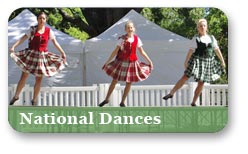Kyla Groeschel's School of Highland Dance
History of Dances
Highland Dances
The Highland Fling is the most famous Scottish dance. It is a celebratory dance that was performed by warriors after battle; some say that it tells the story of a young boy trying to describe a stag to his grandfather after his first hunt. It is danced in place without traveling steps, and is performed at almost all Highland dance competitions.
The Sword Dance requires the dancer to execute a series of leaps and turns over a pair of swords placed in a cross formation on the floor. Legend has it that warriors performed this dance the night before battle; if the warrior stepped on the sword, it was a sign that he would be injured, but if the swords were accidentally kicked, it was an omen of his demise on the battlefield. Traditionally, the dancer claps toward the end of the dance, signaling the piper to speed up the tempo.
The Seann Triubhas (pronounced "shawn trews") means "ancient trousers" in Gaelic and is associated with the proscription of the kilt after the 1745 rebellion of the Scots. This dance includes shedding, or shaking of the legs, to symbolize kicking off the trousers and the return to the beloved kilt.
The Strathspey and Highland Reel features four dancers using traveling steps to move around each other. Though they appear to be dancing together, each dancer is judged individually in competition.
The Strathspey and Half Tulloch is another "group" dance that is judged individually. Legend has it that this dance was created by the congregation of a Scottish church in the Highlands, as they tried to keep warm while waiting for the pastor to arrive.




